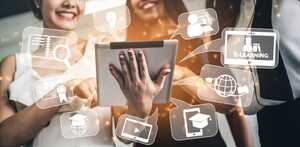The ‘hybrid classroom’ was born in the midst of the pandemic when educators had few options but to move the learning environment entirely online lest students see their educational development suffer as a result of the global health crisis.
But now, in a post-pandemic world, what is the role of the hybrid classroom and the concept of blended learning, and do educators and administrators in the UK have the necessary training and resources to implement this modern, technology-dependent educational approach?
The early signs are that both teachers and students recognise the advantages of a hybrid learning paradigm. According to a report compiled by EdTechnology last year, 96% of teachers believe that the use of technology positively impacts participation and learning within the classroom, while 73% said that blended learning specifically, increased student engagement. In the same report, 82% of students actually preferred blended learning to traditional teaching environments.

Indeed, at its core, blended learning has allowed educators to drastically rethink conventional teaching practices and consider how the educational experience might be made more engaging and accessible for all students. Before we discuss some of the benefits involved in the blended learning model—and, equally, what challenges must be overcome for it to become universally effective—a pressing question:
What is the blended learning model?
In short, the blended learning model is a teaching approach that combines traditional face-to-face instruction with online learning activities. Its primary aims are to leverage the benefits of both in-person and digital learning to create a more effective and engaging educational experience.
Typically, in a blended learning model, students participate in a mix of classroom-based and online learning programmes, often through a learning management system (LMS) or comparable online platform.
Blended learning models often incorporate a mix of independent study, collaboration, and whole-class instruction. ‘Station rotation’, where students move between learning stations or modes based on a set schedule, is an approach commonly used within blended learning.
Regardless of the specific model employed, there are several key attributes that educators and course designers adopt within blended learning experiences:
The limitations of art technology
As with any technology integration, there are a number of challenges schools must navigate to truly realise the potential of creating an ICT-friendly art space. Unfortunately, when it comes to pinpointing these limitations, we encounter some familiar themes:
Engaging content
Blended learning sessions often begin with captivating content introductions that ignite student engagement. By using multimedia elements, interactive materials, and real-world connections, educators can capture students' attention and stimulate their curiosity from the outset.
Chunking strategies
To promote skill development, blended learning models include ‘chunking strategies’ in which educators are able to break down complex ideas or skills into manageable segments—all the while providing clear demonstrations and step-by-step guidance. This approach helps students grasp new information and build their knowledge progressively.
Understanding and assessments
Regular checks for understanding and assessments aligned with the learning goals are key components in blended learning. These can take various forms—anything from quizzes, and interactive activities, to project-based assessments. By analysing student understanding throughout the learning process, educators can identify areas of improvement and provide timely feedback.
Interaction and collaboration
When used effectively, blended learning should create opportunities for students to interact and collaborate with their peers. Whether through online discussions, group projects, or cooperative learning activities, fostering collaboration enhances students' ability to process information, exchange ideas, and develop a deeper understanding of the subject matter.
Scaffolding for meaningful connections
‘Scaffolding’ enables learners to connect their understanding with meaningful, real-life scenarios. Educators can provide supportive structures, resources, and guidance that gradually fade as students achieve mastery in a subject. This approach gives students the freedom to apply their knowledge in a non-academic context and promotes deeper learning.

The benefits of blended learning
IIn essence, a blended learning model can be applied to any teaching approach that values traditional education techniques while integrating and utilising modern technology to enhance the learning experience as a whole. There are, however, some key benefits which a successful blended learning programme should hope to nurture.
Increased flexibility
Students are given more autonomy and control over their own learning practices; enabling them to fit their education around busy lifestyles while removing the traditional barriers of time and location in which to learn.
Enhanced interaction
Blended learning provides a wonderful opportunity for collaboration at a distance, where individual students from all over the world can work, collaborate and engage virtually in an academic environment.
Diversity in content
A broad and rich range of course content delivered in a hybrid classroom can improve engagement and add to the authenticity of the learning experience to help students achieve their long-term goals.
Student engagement
Technology that is familiar to students can be used to generate highly innovative practices for teaching and learning. Enriching blended learning content with appropriate images, audio and video can add variety and impact. There are also benefits for disabled students, who before the pandemic might have experienced challenges with attending in-person lectures or engaging with course content.
Types of blended learning model
While there is some degree of overlap between the various definitions of blended learning models, and the precise parameters of each are open to interpretation, there are a number of practices that have been recognised amongst educators as the most effective.
Each model varies in terms of teacher responsibilities, administrative requirements, and instructional emphasis. What’s more, schools may choose to tailor their approach to allow more flexibility for both students and teachers.
Flipped Classroom Model
In the flipped classroom model, students access instructional materials, such as pre-recorded lectures or readings, online before attending in-person classes. Classroom time is then utilised for collaborative activities, discussions, and problem-solving. In a maths class, for instance, students might watch a video explaining an algebraic concept at home and then come to class to work on practice problems with the guidance of the teacher.
Rotation Model
The rotation model involves students moving between different learning stations, both online and offline, based on a predetermined schedule. In a modern language class, students may spend a portion of their time working on grammar exercises using online language software, then rotate to another station for group discussions or conversational practice with the teacher or peers.
Flex Model
In the flex model, students have control over the time, place, and pace of their learning. While the majority of the education environment is typically online within the flex model, where students can access resources and complete assignments at their convenience, they also have regular in-person check-ins and support from teachers.
Self-Blend Model
Using the self-blend model, students choose to supplement their traditional in-person learning with online courses or resources. This model allows students to pursue additional topics, interests, or advanced courses that may not be available in their school's curriculum. A student with a keen interest in computer programming, for example, may take an online coding course outside of their regular school timetable.
Enriched Virtual Model
The enriched virtual model allows students to engage in online learning which is then supplemented with scheduled in-person sessions for particular activities. Here we might see a biology student conduct virtual experiments online and then come to the lab to apply what they have learned in the virtual element of their programme.

Challenges faced by the blended learning model
While blended learning offers numerous benefits—as with any new and innovative learning model, there are potential challenges to overcome before it can be introduced fully into the fabric of the education system.
Inadequate infrastructure and resources
Naturally, the effective introduction of blended learning requires a robust ICT infrastructure and sufficient resources. Schools and MATs must have reliable internet access, appropriate hardware, software licenses, and technical support to ensure a seamless online learning experience for students and teachers. Limited resources, underfunding, and outdated IT estates can restrict the successful implementation of blended learning within a school.
Increased workload for teachers
Particularly during the transitional phase, a fully-integrated blended learning programme would increase the workload for teachers. Developing online content, monitoring student progress, providing timely feedback, and managing online discussions require additional time and effort. Without sufficient support from technology providers, this additional workload could lead to teacher burnout or compromise the quality of instruction.
Reduced social interaction
While blended learning incorporates online collaboration, digital engagement is no substitute for the face-to-face social interaction found in traditional classrooms. Limited in-person contact can affect the development of social skills within children, as well as having an impact on peer-to-peer learning, and a sense of community among students.
How can Computeam help?
The school system has gone through seismic changes in the last few years and undoubtedly the pandemic pushed many teachers out of their comfort zones, requiring them to embrace and experiment with new technology tools, learning platforms, and instructional methods to engage students online, in virtual classrooms, and on hybrid schedules.
Despite the challenges faced by educators since 2020, those still trying to find steady footing in an ever-moving educational landscape, blended learning has emerged out of the chaos of lockdown as a transformational opportunity for both staff and students. With the right kind of implementation and funding, it’s a model that could become the educational norm in the coming years.
If you’d like to find out more about the use of technology in the classroom, or how an effective ICT strategy can help your school offer an effective blended learning programme, please do get in touch.

Computeam on... The Benefits of Using Video Game Technology in the Classroom
Read about the teacher recruitment crisis and how tech can help play its part in easing some of the ongoing concerns for educators



 Learning Locker
Learning Locker Climate project
Climate project